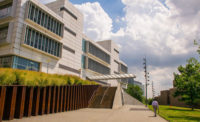A man who had been mulling over a sound-modulating bench with his companion used verbal shorthand to explain the depth of this next exhibit, representing a design for the "Hotel Pro Forma," a conceptual project for Denmark. "It's WYSIWYG," he said.
"I'm not familiar with them," his companion replied.
Refreshingly though, What You See Is What You Get doesn't begin to describe "New Hotels for Global Nomads," the exhibition at the Cooper-Hewitt National Design Museum where the man and his companion pondered the Hotel Pro Forma. That one man's thought-provoking concept piece is another one's head-scratcher is a given, and Cooper-Hewitt embraces this creative dichotomy with a spirit of both whimsy and exploration as it tackles the possible future and recent past of hotel design. At times alternating between thought-provoking and nostalgic, hokey and very smart, the museum executes the exhibit's core purpose—demonstrating the history of hotels as design laboratories and fantasy experiences—with enthusiasm and success. In dissecting the parts that strive to make the whole—urbanism, mobility, business, nature and fantasy—you can find the matters to quibble with.
The Cooper-Hewitt's Donald Albrecht plays both curator and benefactor with his exhibit, reconnecting with urban hotels' pasts in the catalogue and riffing on possible futures in a number of exclusive commissioned works. In between are a host of projects, realized or only dreamed, that chart the contemporary boon in all aspects of the hotel experience. The breadth of the included works is the show's core strength. Where else will you see images of Jean Nouvel Atelier's work side-by-side with a heart-shaped whirlpool?
"New Hotels" begins beyond a screen of front-desk bells. Do not disturb tags, room keycards and other hotel paraphernalia appear as decorative motifs throughout. It's not until you move through a few rooms that things begin to get interesting. Video artist Jeff Gompertz has made a video of people using Japanese capsule hotel units (he certainly has a future as a security guard) that should be quickly ignored in favor of crawling in one of the four capsules on display. Once you get past the notion that you're inside a horizontal refrigerator, what works with the capsules—the simplicity, the quiet, the basic needs it meets—may make you consider a family vacation in Japan. Adjacent to the capsules you can walk through a portion of Joel Sanders Architect's "24/7" room. Sanders's work is a hyped-up Ryokan room for the 21st century-high-tech and multipurpose yet sparse. The full-scale model only hints at the design's potential.
Around the side of Sanders' work is a clever piece by Diller + Scofidio. In "Interclone Hotel" a quartet of identical rooms in Mexico, India, Vietnam and Uganda are overlaid with different decorating patterns and legends depicting local socioeconomic conditions. The wit of the project is fleeting, though. Perhaps it's better suited to the pages of a magazine than to an exhibit. You'll likely find yourself drawn back across the room to a video monitor recycling Spike Jonze's "Weapon of Choice" video. Christopher Walken dancing in a dim LA hotel lobby is always more interesting than a designer's sermonette.
A hallway lined with over 700 postcards of motels and some hotels is the only detailed appearance that the motel makes in "New Hotels" and it's out of place. If hotels are a place to experiment with design and fantasy in an urban context, motels are something entirely different. A response to our post-WWII obsession with the automobile and mobility, the motel meets a generally divergent set of needs. Then again, maybe Albrecht thought they were just an interesting decorating spin for the hallway, which they are.
The show really picks up speed on the second floor because of an eclectic playfulness that's largely missing from the first floor. It's up here where photos of Jean Nouvel Atelier's The Hotel in Lucerne aren't far from a tub out of the Mt. Airy Lodge in the Poconos. With its film stills of couples projected onto the ceiling, The Hotel offers an enlarged and glorified reflection of visitors' pending or imagined eroticism. It's not a far leap, then to the novelty tubs and mirror-ceiling rooms of romance hideaways like the Mt. Airy Lodge




Post a comment to this article
Report Abusive Comment